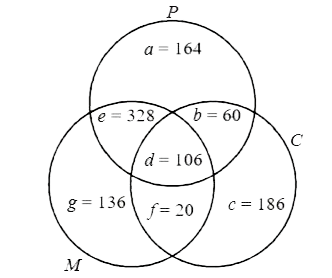Find the pairs of equal sets, from the following sets, if any, giving reasons:
A={0}
B={x:x>15 and x<5}<br>C{x:x−5=0}
D={x:x2=25}
E={x:x is an integral positive root of the equation x2−2x−15=0}
The correct Answer is:Clearly, C=E
Step by step video & text solution for Find the pairs of equal sets, from the following sets, if any, giving reasons: A={0}B={x:x gt 15" and "x lt 5} C{x:x-5=0} D={x:x^2=25} E={x:x is an integral positive root of the equation x^2-2x-15=0} by Maths experts to help you in doubts & scoring excellent marks in Class 14 exams.
Updated on:21/07/2023Topper's Solved these Questions
- SET THEORYBook:DISHA PUBLICATIONChapter:SET THEORYExercise:Practice Exercises (Foundation Level)
Explore 14 Videos
- SET THEORYBook:DISHA PUBLICATIONChapter:SET THEORYExercise:Practice Exercises (Standard Level)
Explore 31 Videos
- RATIO,PROPORTION AND VARIATIONBook:DISHA PUBLICATIONChapter:RATIO,PROPORTION AND VARIATIONExercise:Test Yourself
Explore 15 Videos
- TIME AND WORKBook:DISHA PUBLICATIONChapter:TIME AND WORKExercise:Test Yourself
Explore 15 Videos
Similar Questions
In a class of 70 students, each student passed Hindi or English. Of them, 15 students passed both Hindi and English, and 40 students passed Hindi. Find the number of students who passed English.
View SolutionRead the information given below and answer the questions that follow.
The result of an exam is given below. Out of 1000 students who appeared
(i) 658 failed in Physics
(ii) 166 failed in Physics and Chemistry
(iii) 372 failed in Chemistry, 434 failed in Physics and Maths
(iv) 590 failed in Maths, 126 failed in Maths & Chemistry.
Find the number of people who failed in Chemistry but not in Physics. (assuming that none is passed in all subjects).

We have the following equations:
a+b+c+d+e+f+g=1000
a+b+d+e=658, b+d=166
b+d+c+f=372
d+e=434 as in the figure.
d+e++g=590, d+f=126. Find the values.
View SolutionThe salaries of A,B,C are in the ratio 2:3:5. If the increments of 15%,10% and 20% are allowed respectively in their salaries , then what will be the new ratio of their salaries ?
View SolutionOne man can do as much work in one day as a woman can do in 2 days. A child does one third the work in a day as a woman. If an estateowner hires 39 pairs of hands, men, women and children in the ratio 6:5:2 and pays them in all Rs. 1,113 at the end of the days work. What must the daily wages of a child be, if the wages are proportional to the amount of work done?
View SolutionAre these sets equals? A={x:x in Z and x^(2)<=4}B={x:x in R and x^(2)-3x+2=0}
View SolutionSelect the pair of equal of equal sets from the following :
A={0}
B={x:x>15andx<5,x∈N}
C={x:x−5=0}
D={x:x2=15}
E={x:x is positive root of x2−2x−15}=0.
View SolutionWrite the empty and singleton set from the following sets :
(i) A={x:x+2=5}
(ii) B={x:x2−8x+16=0}
(iii) C={x:x+2=3and2x=1}
(iv) D={x:x<x}.
View SolutionState which of the following sets are finite and which infinite :
(i) {x:x is a positive integral root of x2−2x−15=0}
(ii) {x:x is human being in the world}
(iii) {x:x is a multiple of 3}
(iv) {x:x is a real number between aand2}.
View Solutionसमान समुच्चयों के युग्म छाँटिए ,यदि ऐसा कोई युग्म है, और कारण भी बतलाइये:
A=[0],B=[x:x>15औरx<5],
C=[x:x−5=0],D=[x:x2=25],
E=[x:x समीकरण x2−2x−15=0 का एक धन पूर्णांक मूल है]
View SolutionWhich of the following parir of sets are equal? Give reasons.
(i) A={−3,−2,−1,0,1,2,3,}andB={x:x∈Zandx2<10}
(ii) A={0}andB={x:xis root of the equation x2−2x=0}
(iii) M, the set of letters of the word SCHOOL and N. the set of letters of the word SCHOLAR.
View SolutionWhich of the following are examples of null set?
(i) A={x:x is root of equation x + 3 =0 and x∈N}
(ii) B={x:x∈Z,9x−8=0}
C={x:x is letter of the word MAKE}
View Solutionनिम्नलिखित समुच्चयों में से समान समुच्चयों के युग्म छांटिये।
A={0}
B={x:x>15 और x<5,xεN}
C={x:x−5=0)
D={x:x2=25}
E={x:x समीकरण x2−2x−15=0 का धन मूल है }
View Solutionनिम्नलिखित में रिक्त और एकल समुच्चय बताइए-
(i) A={x:x+2=5}
(ii) B={x:x2−8x+16=0}
(iii) C={x:x+2=3 और 2x=1}
(iv) D={x:x<x}
View SolutionState which of the following sets are finite and which are infinite :
(i) A={x:x∈Nand(x−1)(x−2)=0}
(ii) B={x:x∈Nandx2=4}
(iii) C={x:x∈Nand2x−1=0}
(iv) E={x:x∈Nandx is prime}
(v) D={x:x∈N and x is odd}.
View SolutionGiven A={x:x is a root of x^(2) -1=0} B={x:x is a root of x^(2) -2x+1=0} then
View SolutionWrite the following sets in roster form and identify equal sets ( if any)
A={x:x ∈R anfd x2 = 25}
B= {x:x ∈ N and x2 = 25}
C = {x:x ∈ R and x2 - 10x+25 = 0}
D = {x:x ∈ N and x2 - 8x+15=0}
View Solution